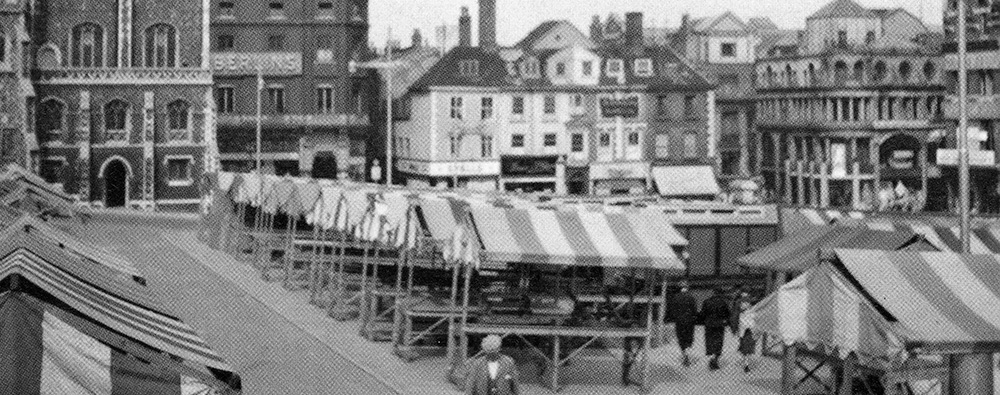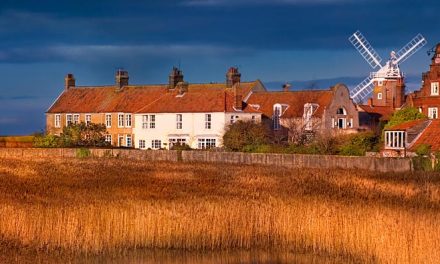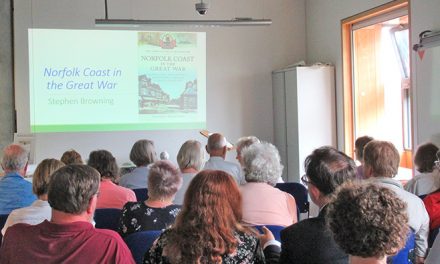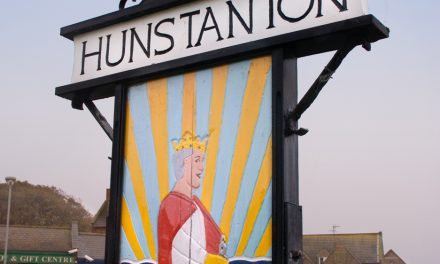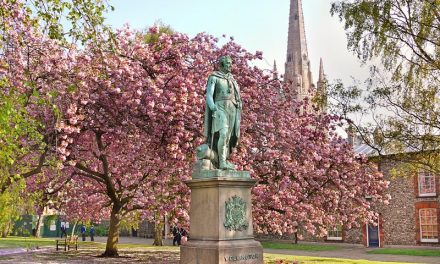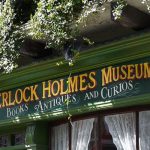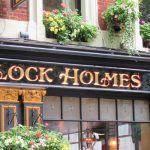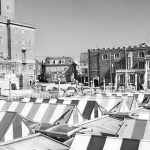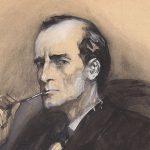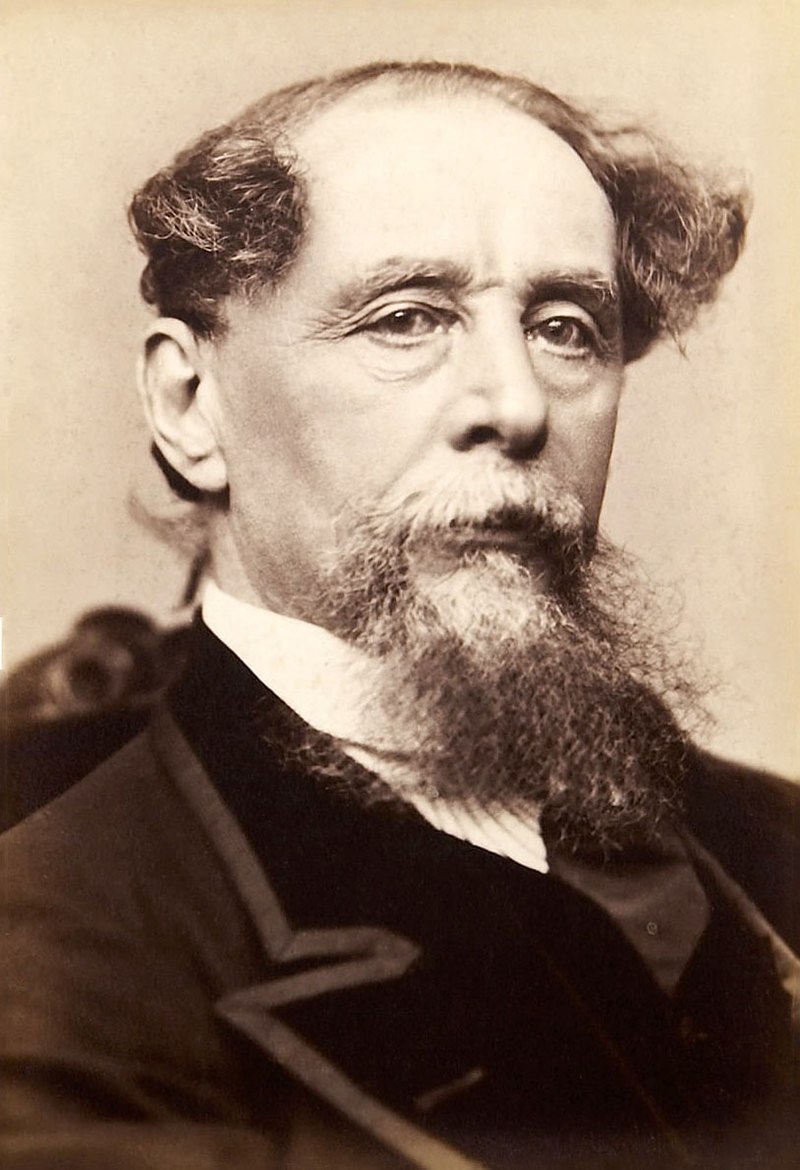A new book published 7 November 2018: NORFOLK AT WAR 1939-45 by Stephen Browning. It is a paperback from Pen and Sword: Priced at £12.99, it has 336 pages with over 300 illustrations. It traces the war, year on year, from the perspective of the people of Norfolk and will be available from Jarrold, Waterstones, City Books and bookshops all over the country as well as from the major internet sites such as Amazon.
Here, in snippets from the book, are 20 facts that you may not know.
1. THE PRICE OF A HOUSE IN 1939
In 1939, if you were in a position to buy your house, exactly as today the cost varied according to where you decided to live. To give some idea of the market, a detached four-bedroomed bungalow or house in the country or small town would cost perhaps about £500. If you wanted to live in a better part of Norwich, the local press of 1939 shows that this amount would buy you possibly a good three-bedroomed terrace property with garden or a two/three bedroomed semi-detached house with garden.
2. THE FIRST EVACUEES
Evacuation began on Friday 1st September when the first of 20,000 children arrived over four days at Thorpe Station in Norwich. Scouts and Guides helped put them all in buses which would take them to dispersal centres in nearby schools. Here they were given a quick inspection for lice and colds and each given a bag of rations containing one can of beef, milk, two small blocks of chocolate and a pound of biscuits.
Other children arrived on steamers which brought them from the Thames in London to Lowestoft, Great Yarmouth or Felixstowe.
3. ENTERTAINMENTS CARRIED ON
In Norfolk as a whole, citizens tried to retain elements of their life as if a war was not happening. Cinemas and theatres continued to do good business and dance halls came into a life of their own. As the war progressed, the standard of film went down. There was often a feature plus a government piece such as ‘Fuel Flashes, ‘The Kitchen Front’ or ‘Battle Orders’. The few big production films were wildly popular, feeding a need for escapism and laughter. These included some still famous today: ‘Come on George’ with George Formby, ‘the Murder in Thornton Square’ with Charles Boyer and Ingrid Bergman, ‘Bulldog Drummond Strikes Again’ with Ronald Colman and Loretta Young and ‘Goodbye, Mr Chips’ with Robert Donat.
On the radio, some famous programmes were ‘Can you hear me, Mother?’ with Sandy Powell, and Sandy’s Half-Hour with Sandy Macpherson which, at its peek, received 5,000 requests a week for music requests from servicemen. The most famous, however, was ‘ITMA’ (It’s That Man Again) with Tommy Handley which, on Thursday evenings at 8.30 pm brought people The Minister of Aggravation and Mysteries which existed in the Office of Twerps. He invented characters such as Funf, the German spy, and Mrs Mopp, a charwoman who always entered with the ribald ‘Can I do you now, Sir?’
The two most famous songs of the war were probably ‘Hang Out the Washing on the Siegfried Line’ which sold over 200,000 copies in the first week of publication and Flannagan and Allan’s ‘Run Rabbit Run’.
4. THE BATTLE OF BRITAIN STARTED OVER NORWICH
The first event of the Battle of Britain began at 4.40 in the morning of 10 July when three Spitfires from No 66 Squadron took to the air from RAF Coltishall, eight miles north of Norwich city. They found a single German Dornier bomber which raked one of the Spitfires with bullets, forcing it back to base. The other two pursued the bomber and shot it down over the sea; three of the crew were seen adrift in the water. Soon afterwards RAF Martlesham near Ipswich was attacked by several planes and eighteen bombs dropped – fortunately any damage was limited to the edge of the airfield and there were no casualties.
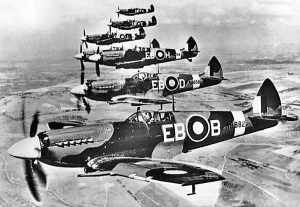
5. GREAT YARMOUTH WAS A PRIME TARGET
On the Norfolk coast, Great Yarmouth along with its southern neighbour, Lowestoft, suffered almost continuous harassment. Over half the population of this coastal belt had been evacuated and this saved countless lives. The raid on Yarmouth and nearby Gorleston on 7-8 April 1941 destroyed more property than any other in the war over the whole of East Anglia.
6. HENRY BLOGG OF CROMER CARRIED ON HIS HEROIC WORK
Henry Blogg, a hero of the Great War, continued his exploits in the second. He was now sixty five years of age. He was three times awarded the Gold Medal of the RNLI.
7. CHURCHILL SET UP ‘BRITISH RESTAURANTS’
Winston Churchill championed the setting up of ‘communal feeding centres’ although he hated that term as it reminded him of communism and the workhouse. Thus, they became ‘British Restaurants’ and fantastically popular they were, too. For, say, lunch you bought a token, from 1 penny to 6: 1d (old term for a penny) would buy a bowl of soup and a piece of bread while 6d bought a substantial three course meal.
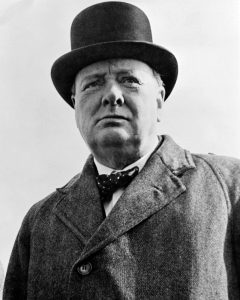
8. THE CONFLICT INSPIRED SOME FAMOUS POEMS, INCLUDING THIS ONE
High Flight
Oh! I have slipped the surly bonds of Earth And danced the skies on laughter-silvered wings; Sunward I’ve climbed, and joined the tumbling mirth Of sun-split clouds – and done a hundred things You have not dreamed of – wheeled and soared and swung High in the sunlit silence. Hov’ring there, I’ve chased the shouting wind along, and flung My eager craft through footless halls of air. Up, up the long delirious burning blue I’ve topped the wind-swept heights with easy grace Where never lark, or even eagle flew. And while with silent lifting mind I’ve trod The high untrespassed sanctity of space, Put out my hand and touched the face of God.
John Magee
9 June 1922 – 11 December 1941. Like Rupert Brooke, whom he admired, John Magee had been educated at Rugby. He died in a mid-air collision over Lincolnshire where he is buried.
9. KING EDWARD VII SCHOOL WAS ATTACKED AND THE FIRES PUT OUT BY SCHOOLBOYS
Kings Lynn was attacked twice in June 1942. In the early light of 12the a lone Dornier was responsible for the deaths of seventeen civilians and a number of service personnel. The Eagle hotel and nearby premises were destroyed. On 30 June five bombs lodged in the roof of King Edward VII Grammar School, masters and boarders – who had gone to bed – rushing out onto the roof to douse the flames. The dormitories where dozens of boys had been sleeping were burnt out.
The author was a boarder at King Edward VII Grammar School many years later and slept in the rebuilt dormitories for the six years of his secondary education. We boys knew of this tale, of course, and many times tried to work out how it was possible to get onto the roof from our dormitories. It was not: the only way would have been if the walls of the dormitories and adjacent washrooms had been blasted out, which was quite possible. The only other way was through the circular stairs off the main hall of the school, via the Geography room – this was proved when several boarders were caught on the school roof in their pyjamas at 3 in the morning.
10. WHY WERE THE RAIDS IN 1942 CALLED THE ‘BAEDEKER’ RAIDS?
The Baedeker Guides began in 1827, and quickly became indispensable to many world travellers. The first was of the Rhine and was apparently produced to save tourists having to pay a personal guide. They gained a reputation for thoroughness – Karl Baedeker was once seen climbing the steps of Milan Cathedral, placing a coin on every twentieth step so that his count would be accurate. In 1942 Exeter, Bath, York, Canterbury and Norwich were all selected for maximum damage because, in the words of Baron Gustav Von Sturm, ‘We shall go out and bomb every building in Britain marked with three stars in the Baedeker guide.’ Allied bombers were to destroy the company’s HQ in Leipzig the following year.
11. CONSCIENTIOUS OBJECTORS WERE NOT ALWAYS TREATED HARSHLY
Conscientious objectors regularly came before Norwich courts and their reception was far from hostile. The cause of those who could not find it in their conscience to harm another or fight had gained wider acceptance during the Great War and now it was no different. Providing a person was prepared to do some non-combatant service, they could be excused: refusal almost certainly meant prison.
12. LORD WOOLTON PIE WAS PROBABLY THE MOST FAMOUS RECIPE OF THE WAR.
It was reputedly created at the Savoy Hotel, London by Francis Latry. It was named after Lord Woolton who became Minister of Food in 1940. It contains no meat. Ingredients: 1 lb each of potato, spring onion, cauliflower or cabbage, carrot, swede, 1 teaspoon Marmite of similar, tablespoon oatmeal. Other vegetables can be substituted which, in Norfolk, would probably include peas as crops reached record levels, especially in 1944 and 1945. For the pastry: 6oz flour, 1 and a half oz butter, 1 and a half oz lard, 2oz raw potatoes.
13. THE FIRST ATTACK ON BERLIN CAME FROM RAF MARHAM
Three Mosquitos of RAF Bomber Command, flying from Marham in Norfolk, were the first to attack Berlin – this was on 30 January, ten years to the day that Hitler had been sworn in as Chancellor of Germany. They were over Berlin at 11.am, dropped their bombs and returned to Norfolk safely.
14. THERE IS NO ‘BRIDGE OVER THE RIVER KWAI’
When Singapore surrendered, many men from East Anglia became prisoners of war. They were from three battalions of the Royal Norfolk Regiment, the 4th, 5th and 6th, two battalions of the Suffolk Regiment, the 4th and 5th, and the 1st and 2nd battalions of the Cambridgeshire Regiment. Conditions on Singapore Island were harsh and the poor diet resulted in various health problems – dysentery, ulcers, malaria and eye problems amongst many.
In 1952, the French novelist, Pierre Boulle, wrote ‘Le Pont de la Riviere Kwai’. It is fictional, a story depicting the experiences of British prisoners building the bridge over the Mae Klong (there is no actual Bridge over the River Kwai). Boulle had been a prisoner of war in Thailand. The book won the Prix Saint-Beuve in 1952. A famous film directed by David Lean, ‘The Bridge over the River Kwai’, won the Academy Award for Best Picture in 1957. After the success of the film the Thais faced a problem as large numbers of tourists came to see the bridge, which did not actually exist. The problem was solved by renaming the Mae Klong river the Kwae Yai for several miles – the bridge built by the prisoners being on this stretch.
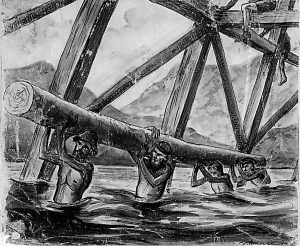
15. THE WOMEN’S LAND ARMY KEPT AGRICULTURE GOING
The Women’s Land Army was highly organised and supplies were not to be sniffed at: on joining, each girl was supplied with two green jerseys, two pairs of breeches, two overall coats, two pairs of dungarees, 6 pairs of stockings, three shirts, one pair of ankle boots, one pair of shoes, one pair of gun boots, one hat, one overcoat with shoulder titles, one oilskin or mackintosh, to towels, one oil skin sou’wester, a green armlet and a metal badge: after every six months and again after two years she received special cloth badges culminating after four years with one in scarlet.
16. FIRST ONSHORE ON D-DAY WERE MEN FROM THE ROYAL NORFOLKS
It was decided at these meetings that the 1st Royal Norfolks, and the 7th in following up, should be amongst the first troops to land in France. By the end of May an invasion fleet of nearly seven thousand craft was assembled. The RAF and USAAF were at the same time launching a total of 144,800 bomber missions, losing 1,616 bombers and twelve thousand men. In contrast, the Germans made about 120 reconnaissance missions over Britain in this period.
17. WHAT SIDNEY (BASHER) BATES, VC SAID BEFORE HE DIED
‘Take that, you bastards, and that, and that.’ It was at this time that a twenty-four-year-old corporal in the Royal Norfolks won the Victoria Cross. Sidney ‘Basher’ Bates was advancing against the enemy when his machine gunner and best friend was killed. Seizing the light machine gun, he ran towards the Germans, shooting from the hip, shouting: ‘Take that, you bastards, and that, and that.’ He was shot but his actions had a demoralising effect upon the enemy as he fell, regained his feet and carried on advancing. He was shot again, fell and once more got to his feet at which the nonplussed enemy began to withdraw. He was hit by mortar splinters and fell to the ground for a final time but continued to fire until he passed out. He died two days afterwards.
18. THE FIRST V 1’s ATTACK NORFOLK
Exactly one week after bombers took off from English airfields to begin the D-Day assault, a new weapon reached Britain – the ‘flying bomb’ or ‘doodle-bug’, twenty-seven in all, the first reaching Gravesend in the early morning of 13 June. Later, when they became more sophisticated, deadly and increasingly difficult to shoot down, they were known as V.1s and V.2s. The first one seen from the ground in Norwich flew harmlessly over the city on 26 June.
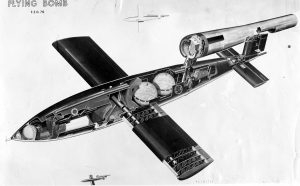
C10/V-1
19. PEOPLE IN 1944 WERE CRAVING ICE CREAM
In the summer of 1944, the ban on going to the seaside had already been lifted with trains and buses to Great Yarmouth, Hunstanton, Cromer and other resorts packed. From November some coastal towns were authorised to clear beach obstructions and the army began to take out mines. There was a particular yearning for ice-cream, such that the Food Minister, Colonel Llewellin, allowed supplies to be made available for its manufacture. Road signs were put back – some pointing to the wrong places – and there was talk of what was reasonable in terms of public street lighting.
20. THE FIRST MAN ON OCCUPIED JAPANESE SOIL WAS FROM NORWICH
On 8.15 am local time on 6 August 1945, an atom bomb was dropped on Hiroshima. On 9 the August another atom bomb was dropped on Nagasaki. The Japanese surrendered and the war was over. The main ceremony of surrender was on board the US battleship Missouri in Tokyo Bay on 2 September. Ten days afterwards, Lord Louis Mountbatten took the formal surrender of all Japanese forces within the South East Asia area command. The first man of the British occupation forces to walk upon Japanese territory was Lieutenant Colin Chapman, commander of the cruiser Newfoundland. He was from Norwich.
Further details of this and other books are regularly updated to my ‘other’ webpage www.facebook.com/stevebrowningbooks Please take a look!

